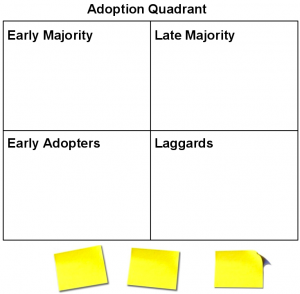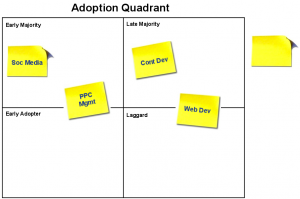
A recent client engagement focused on a pivot strategy based on a 5 year product and service launch history. Through mapping services and their resulting characteristics to an adoption quadrant, we were able to clearly see certain trends in market selection, success rates, revenue and profit results which the client had previously not realized. How can this be an eye opener for your business endeavors?
Adoption Quadrants (The Innovation Curve)
Found in a variety of disciplines, Everett Rogers defined the Innovation Curve in the mid sixties, largely describing how ideas evolve from nascent to mainstream. In change management,  a similar notion is used to strategically determine where to begin driving change (with the early adopters). Another example of its conceptual use would be in enterprise architecture, where systems and platforms are mapped to manage risk and cost. Marketing people consider four stages of product life cycle, also a similar concept.
a similar notion is used to strategically determine where to begin driving change (with the early adopters). Another example of its conceptual use would be in enterprise architecture, where systems and platforms are mapped to manage risk and cost. Marketing people consider four stages of product life cycle, also a similar concept.
I like to think of the quadrant in terms of adoption, as the fundamental challenge in sales and market selection is convincing people to become customers and clients. They need to adopt one’s product or service. The quadrant represents four categories – early adopter, early majority, late majority and laggard.
Our Client`s Discoveries
Working through a set of strategy sessions to better align service offerings with markets, we first set about defining the company’s context – where it had been, what it had done and what it had learned.  I call this historical pattern a trajectory – it is important to understand both where the business will continue to go and what factors require change to create a different trajectory.
I call this historical pattern a trajectory – it is important to understand both where the business will continue to go and what factors require change to create a different trajectory.
As we worked through the history, a pattern started to emerge – the company’s offerings were consistently successful in low margin circumstances. This often led to the sunsetting of a service due to its low profitability. To work through the developing patterns and lessons, we mapped the offerings to the adoption quadrant.
The client realized a few epiphanies with past and current service offerings:
- Commodity services were easy entry point: it was not accidental that more market mature offerings were easier to sell and brought new customers.
- Margins are low and ultimately unsustainable as a niche service provider: Given many providers and solutions in a well established marketplace, margin was low and required a business model with significant sales to sustain a feasible profit.
- Emerging market customers are often not the same people. More on this in a moment.
This became an “ah ha” moment for the client, whose business strategy was primarily focused on new market offerings. They consistently had difficulty selling solutions that were using the latest and greatest technologies and techniques. In place the lower margin and well known offerings sold but in a market the required a completely different business model to achieve reasonable success.
Back to emerging market customers, we discussed who likely targets were for “new ideas” – the early adopters and early majority:
Large Corporations: Simply they can afford to dabble in new ideas. What may be a large sum of money to a small start up or new venture can be a small investment or purchase by a large corporation, looking to better solve an existing problem or create a new capability.
Those with a Big Pain: Companies with an issue that is causing significant harm to the business or inhibiting significant opportunities are potential clients. Often these companies have tried the traditional solutions and come up short.
Venture Capitalists: Obviously not a customer in the mainstream sense, nonetheless VC’s are often one of the first set of people to buy into the value of an idea. Ultimately this is not a marketplace, per se, but it is important to understand them as a group in the early adopter quadrant.
Another key discovery for the client lay in their existing customer base which was purchasing late majority services. While existing customers build a business base, our client’s existing (and previous) customers were late majority buyers, rarely surfacing challenges significant enough to sell them higher margin, more “new tech” solutions. These customers were valuable for some existing business base, but were dead ends to a corporate strategy of selling innovative products and services. Given our client’s “new tech” product and service focus, the alignment challenge between products and customers became evident through the adoption quadrant.
Characteristics in the Quadrant
Once we had understood where the products fit in the quadrant, we began to articulate the characteristics of the market segments to determine why sales were not occurring in the company’s primary areas of focus.  While there are four quadrants, market characteristics significantly overlap between two quadrant pairs – Early Adopter/Early Majority and Late Adopter/Laggard.
While there are four quadrants, market characteristics significantly overlap between two quadrant pairs – Early Adopter/Early Majority and Late Adopter/Laggard.
We spent less time discussing key characteristics of the latter market pair, where entry and execution was neither the company’s desire nor sustainable. Focus on the first quadrant pair was more important as the client’s desired product and services offerings had to penetrate the early quadrants to be successful.
Thinking of the product and service match to the market in terms of adoption can illuminate the characteristics of a product and services launch, the types of potential customers to seek and the nature of the sale.







You must be logged in to post a comment.